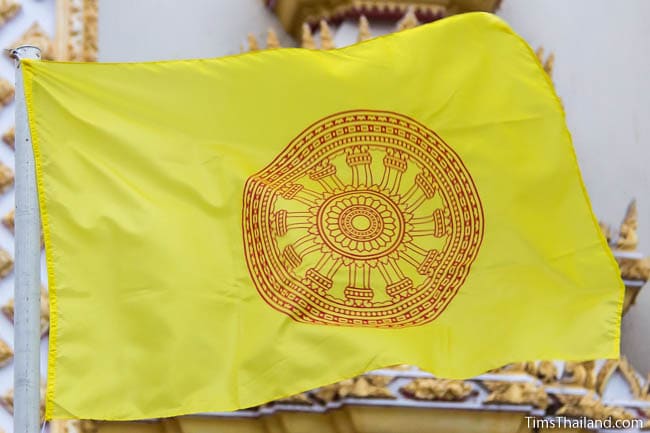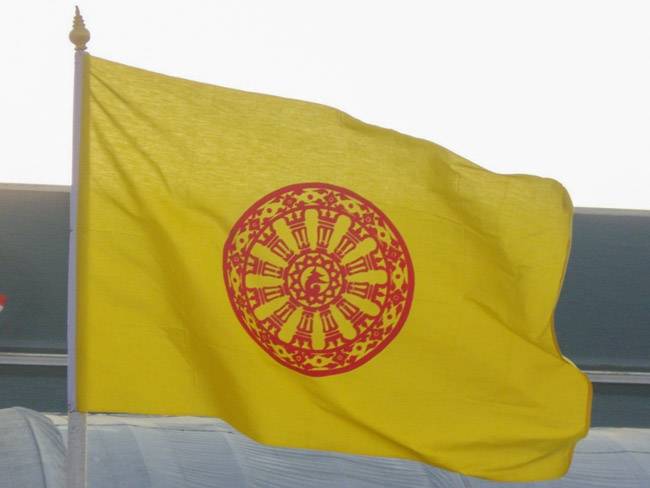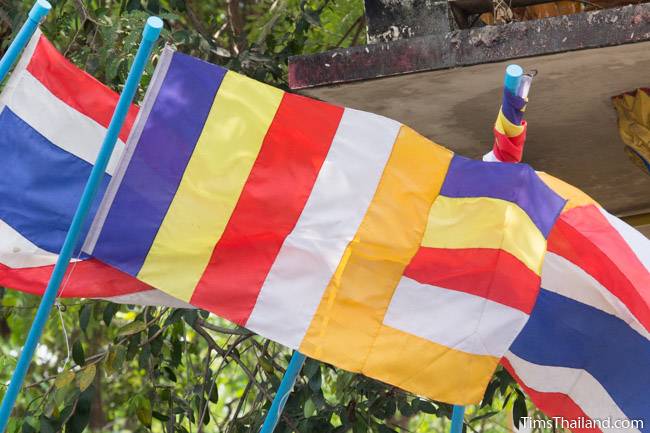The Thai Buddhist Flag
Nearly every temple in Thailand flies the yellow and red tong dhammachak (“Thai Buddhist flag”) which was officially introduced by the Thai sangha in 1958. The red circle is a dharma wheel (dhammachak in Thai) and it represents dharma, the teachings of the Buddha. Also known as the “wheel of law,” it was metaphorically set in motion when the Buddha gave his first sermon, known as the Dhammacakkappavattana Sutta (SN 56.11), after reaching enlightenment. It’s one of the earliest Buddhist symbols, and sculptures and paintings of it are common in Buddhist temples around the world.

The particular dharma wheel design used for the Thai Buddhist flag is full of symbolism. While many dharma wheels have eight spokes, for the “eightfold path” (a general blueprint of how people should live their lives: right livelihood, right concentration, etc.), this flag usually uses 12 to represent the “four noble truths”, which were introduced to the world in the Buddha’s first sermon. It wasn’t until after the Buddha was able to recognize, ponder, and understand each of the noble truths (3 phases X 4 noble truths = 12) that he reached enlightenment. He called it his “three-round, twelve-permutation knowledge and vision concerning these four noble truths.” The wheel’s hub has two lotuses, symbol of purity and awakening, and the spokes are pillars with inverted lotus flowers at the top, Buddhist icons since the time of the Buddhist patron Emperor Ashoka in the 3rd century BCE and still very common in Thai temples today. Nothing I read (nor the monks I spoke to) mentioned any symbolism in the wheel’s rim, but it’s hard to believe that the three layers don’t represent the Buddha, the Sangha (community of monks), and the dharma. The yellowish-orange color is the same traditionally used for monk’s robe, although the flags are now often bright yellow instead of the muted orange. As far as I could determine, the red was chosen not for any symbolism, but because it looked good.
There’s no single way to draw the wheel on the flag, though the one shown in the photo above is very common. One noteworthy though rare variant puts the symbol of King Rama 9 in the hub. It’s not an ‘Om’ symbol as some websites say.

The International Buddhist Flag
Although its use in Thailand is rare, some temples also display the international Buddhist flag, which was designed and used in Sri Lanka in the 1880s and adopted internationally by the World Buddhist Congress in 1952.

The design comes from the six-colored aura that emanated from the Buddha’s body during his meditation session in the fourth week after reaching enlightenment. When creating the flag, the colors were assigned meanings: blue represents loving kindness for all living beings; yellow is the middle way, the avoidance of extremes; red is the blessings and achievement that come from following dharma; white is the purity of dharma; and orange is the wisdom of dharma. The sixth color on the end stripe is a combination of the other colors (since this can’t actually be depicted it’s shown in its parts) and it represents the universal truth of dharma.
Some places and some sects around the world use non-standard versions of this flag by changing the colors and/or making the combination column wider than the others, though I don’t remember ever seeing any of these in Thailand.
King Rama 9-version flag photo by Xiengyod from Wikimedia Commons.
2 thoughts on “Buddhist Flags in Thailand”
thank you very much for all these explications. Your web site is very nice.
Thanks for the compliment.